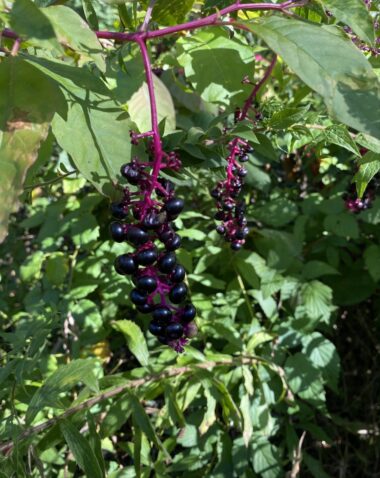American Pokeweed
There’s a plant native to America that’s as diverse and interesting as its residents themselves.
American Pokeweed, also called Pokeberry among other names, has a long history of varied use by Native Americans and the colonists, including dyeing fabric, ink for writing, medicine and even food. “Phytolacca” means red dye plant. Phytolacca americana, however, is highly toxic if consumed, since all parts of the plant are poisonous.
Form: Pokeweed is an herbaceous perennial shrub (non-woody), ranging from 4-12 feet tall and 2-5 feet wide on average. The stem can be up to 2 inches wide and is a vibrant pinkish-purple with extensive branching. The bright green leaves are elliptic, smooth, and can be quite large, even up to a foot long and 4-7 inches wide. Pokeweed has a perennial root stock and also spreads by seeds.
Habitat: Pokeweed prefers moist areas with part shade like riparian zones, oak forests, vineyards, and orchards. It also thrives in disturbed areas, roadsides, forest edges, parks, fields, and even ornamental landscapes. It is considered a weed in many of these locations, but we appreciate this historically significant plant in the damp thickets of Hawk Valley Farm, and so do the animals who live there.
Flowers & Fruit: Racemes or long clusters of small, greenish, white or pink flowers hang from the branched stems of pokeweed in mid-late summer. The flowers become deep purple berries hanging from the bright green leaves and reddish stems in late summer through early fall, making it rather eye-catching. These are not to be confused with elderberries, which look quite similar when in fruit.
Faunal Associations: Late season, juicy pokeberries are an important food source for much of our local wildlife: deer, foxes, opossums, raccoons and a number of other mammals, as well as birds, such as mockingbirds, northern cardinals, robins, and mourning doves. Phytolacca americana is also a host plant for the beautiful giant leopard moth, and white-tailed deer will also consume its leaves and stems. Ruby-throated hummingbirds benefit from the nectar in the small flowers, as do other pollinators, such as bees and flies.
Another remarkable tidbit about Pokeweed…”Researchers at Wake Forest University have discovered that a dye derived from pokeberries doubles the efficiency of fibers used in solar cells to absorb solar energy.” (Source) It’s also playing a role in cancer research.
So look around for American Pokeweed, whether you’re visiting Hawk Valley Farm, or walking along the road. A weed to some is actually an important plant for others.
Other sources:
https://www.wildflower.org/plants/result.php?id_plant=pham4


